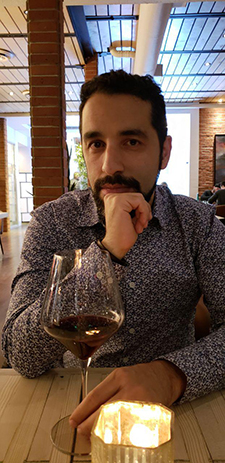For a Lifetime: Rajni Mala Khelawan
in Conversation with Mehdi M. Kashani

Writer and Malahat Review volunteer Rajni Mala Khelawan talks with Far Horizons Award for Short Fiction judge Mehdi M. Kashani about leading an amphibious life, his first love of folk and fairy tales, and what he's looking for in a winning story.
Mehdi M. Kashani lives and writes in Toronto, Canada. His fiction and nonfiction can be found in Passages North, The Rumpus, Catapult, The Malahat Review, Wigleaf, The Walrus, and Bellevue Literary Review, among others. He has work forthcoming in Emrys Journal (for which he won the 2019 Sue Lile Inman Fiction Award), Fiddlehead, Four Way Review, and The Minnesota Review. To learn more about him, visit his website: http://www.mehdimkashani.com
Click here for details on entering the Far Horizons contest.
What are you looking for in a winning story? Is there any advice you would like to give to those who are looking to submit to the Far Horizons Award for Short Fiction competition this year?
The typical answer to this question is, “No preference at all” or “Anything, as long as it is good.” I’ve seen many judges (and editors) say that because otherwise they might bias some participants and scare off others. In a sense, what they say is true. In order to be recognized, a short story should start with a killer sentence and only get better. It should have tightened prose that avoids clichés and, of course, it should stay with the readers long after the end—ideally for a lifetime (I had such experience with O. Henry, Raymond Carver and Jennifer Egan).
But, that said, writing is not a math problem. At some point, the personal touch comes into play and that’s what makes art, in my opinion, more interesting than science. This subjectivity makes one hate, say, Hemingway and love Salinger, though they’re both considered giants.
So, to answer your question, yes, I believe a winning story should have all the above criteria. And when it comes to taste, I, like any other reader, have my personal preferences which I can’t just blurt out here because of bias and also because even I don’t necessarily know my own preferences completely. The element of surprise, the thrill of seeing something you haven’t seen before, is so powerful that it could easily override one’s regular taste. That said, I think I’ve spilled some aspects of my (known) taste throughout this interview like Easter eggs.
Your short story “Dayi” was published in The Malahat Review in Issue #198 (Spring 2017). In this story, there’s a big emphasis on personal relationships, choices, predicaments, and emotions. How does an emerging writer develop characters or make them believable and relatable to people who perhaps do not share the same culture, thoughts, feelings, or beliefs?
When I was doing my master’s degree in Natural Language Processing, I was introduced to the concept of Interlingual machine translation. Interlingua is an abstraction of languages, a representation independent of any specific human language. The idea is, when you want to translate from Language A to Language B, you’ll translate the source text to Interlingua and then from Interlingua to the destination language. It makes life simpler as we don’t have to worry about the quirks of converting two arbitrary languages.
Now, I like to think such Interlingua exists not only to abstract away grammar, but human emotions and feelings too. It is there, you only have to distill and simplify things into an interlingual representation. The foreign reader might not appreciate it as an Iranian, but hopefully close enough.
In more concrete terms, let’s say an Iranian character is on the fence, about to do what is considered a taboo in Iran. It’s a tough, perhaps reckless decision for the character, but the Western reader wouldn’t know this and, without the writer’s assistance, might wonder what all the fuss is about. But the good news is taboos exist in all cultures, they just don’t necessarily correspond. So the writer’s task is to give context about that particular taboo and once the concept is transcended in an ontological hierarchy, it is identifiable in any culture because we all have our qualms about doing something that’s frowned upon.
This is hard. It can’t be heavy-handed, can’t be an information dump, either inline or in a footnote. Readers are smart, they just need hints. It could be hidden in a line of smart dialogue, or by planting a similar incident that involves a side character and showing the consequences (to the protagonist and, more importantly, to the readers).
Like you, I spent my childhood in a different country, thus I experienced a different culture. I grew up being exposed to authors who were not so widely known or appreciated here. So, growing up in Iran, what authors provided a source of inspiration for you and how do they still influence your writing today? And, having lived in Canada for a long time, have your sources of inspiration changed?
Interestingly (and embarrassingly) I didn’t read back in Iran as much as I do now. And, when I did, I was more curious about foreign writers who were in vogue in Iran at the time (European and South American luminaries like Milan Kundera, Jose Saramago or Isabel Allende). My main interest back then was cinema. It still is, but the screen is taking a backseat now to literature. Maybe that’s why many of my stories are visual, ready to be adapted. But, in the limited time I allocated to Iranian literature, I indulged myself, in a very scattered fashion, in classic poetry (Ferdowsi, Hafez, Rumi) and contemporary writers like Sadeq Hedayat.
There’s also another influence worth mentioning. A lady lived with my grandparents. Her name was Batoul and she helped my grandmother with household chores like cooking and raising the kids (my father, my uncles and aunts). No one knew about her life or whether she had any family. When I was around five, she was still with them, but not in good health. Despite her pains, she was an excellent storyteller and every time we visited, she regaled me with folk or fairy tales she had learned in her own childhood (she was illiterate). The passion I had for those stories never repeated for me and I suspect it was the beginning of my love story with the world of fiction that continues today. Ironically, I barely remember any of those tales—only a lingering feeling remains, a sense of anticipation and discovery. Batoul is long gone, but I’m sure some day she will make a cameo in one of my stories.
That’s why I love revisionist stories that retell classic tales with a twist. Recently, I enjoyed reading Steven Millhauser’s “Guided Tour” in Tin House, a modern tribute to “The Pied Piper of Hamelin.”
Originally when you wrote “Dayi,” you wrote it in Farsi then rewrote it in English. I also used to write in Hindi, and then after living in Canada for a few years, I switched to writing in English. It was interesting that this switch in language also affected my dreaming; I stopped dreaming in Hindi and started dreaming only in English. From that moment on, I have not been able to write in Hindi at all. What was the process – switching from writing in Farsi to English – like for you? And can you still easily write stories in Farsi?
Yes, at the time of writing “Dayi,” I was leading an amphibious life. “Dayi” was one of the last stories I originally wrote in Farsi. Most of my stories since were conceived in English. This choice had two very pragmatic reasons: gaining a wider audience and the plague of censorship back in Iran. I have a collection of short stories published in Iran which took more than two years to receive permission from The Ministry of Guidance. And I’d naively thought I had collected my “safest” stories to avoid such a delay.
These days, I feel more at home writing in English. There are, of course, occasions where I wish this or that paragraph were in Farsi.
As for whether I’m able to write in Farsi now, I’m not sure. For the past few years, I haven’t challenged myself. Less out of the worry of what the story will turn out to be than due to the lack of motivation. There’s a Persian proverb that says, a crow tried to strut like a partridge and forgot her own gait. I hope it doesn’t apply to me when the time comes (I hope) to write in Farsi again.
Most recently you won the Sue Lile Inman Fiction Award 2019 for your short story “Relapse.” Congratulations! What is your next project?
Thanks. I have enough raw ideas for short stories to keep me busy for a while. There are also some half-written pieces or the yet-unpublished stories I like to revisit.
At the same time, I’ve recently started a novel about the life of twin brothers in Iran, specifically the story of one brother told by the other.
It is a challenge to shift from short stories to novels. Not only in terms of different technical challenges, but also because of the mindset behind writing a novel. The perseverance. The fact that you’re going to live with these characters for a year or probably more. Curiously, writing novels was always my main interest and objective. I picked up short stories only strategically as it allowed me to experiment with forms and find my niche and voice. But now, I feel more comfortable with the short form. The rather quick turnaround (from their inception to their publication) makes them even more attractive. A brilliant idea just descends upon you and you’re so entranced by it you want to hold everything and bring the story to life on paper! You can’t do that with novels, at least not when you’re a full-time software engineer by profession.
I hope I can find a balance between my novel and these sporadic sparks that turn into short stories.

Rajni Mala Khelawan
* * * * * * * *









